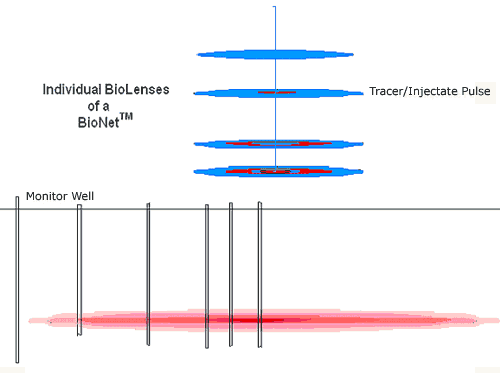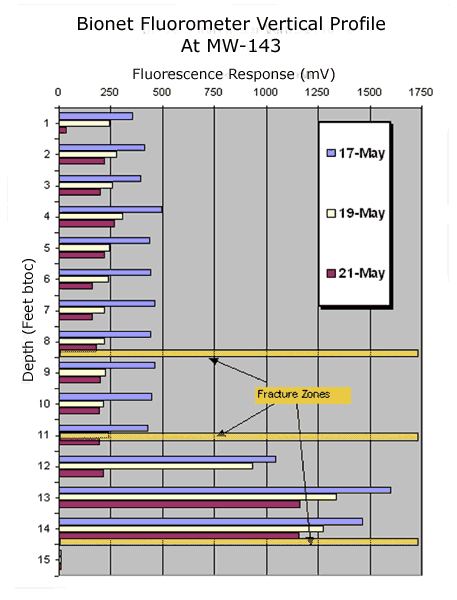Pelorus Uses Cyclops Fluorometer to Characterize Effectiveness of Remedial Fluid Through BioNets™
Parameters: Dye Tracing
Pelorus Environmental & Biotechnology Corp. (Pelorus) provides environmental and biotechnology solutions for water, air, and soil contamination situations. Their environmental services include bioremediation, chemical oxidation, remediation services, water treatment systems, and air treatment systems. Noted for pioneering Environmental Biotechnology applications and hydraulic fracturing and monitoring, their services include: Biocatalyst development for bioremediation and biotransformation of organic molecules to valuable chemical intermediates, and renewable energy processes Molecular environmental diagnostics Fermentation process development and characterization of biodegradation pathways of organic compounds and the delivery of these processes into the subsurface. Project Overview: A recent project, in conjunction with the Artemis Consulting Group was to evaluate the performance of an existing groundwater and soil remediation system. One aspect of the remediation design consists of a patented subsurface treatment area called Bionets. The Bionets are horizontally stacked, hydraulically-emplaced, sand-filled or other solid support filled propagations or fractures. Each Bionet consists of three to four horizontally emplaced fractures. During remediation, the fractures within each Bionet are repeatedly filled with Pelorus proprietary bio-amendments for the purpose of selective dechlorination of specific volatile-organic-compounds (VOCs), otherwise know as constituents-of-concern (COCs). Investigation Approach: Pelorus wanted a way to map or determine the preferred migration path of the injected remedial fluid through the Bionets in both saturated and unsaturated soils at the subject facility. It was Pelorus's intent to use a Turner Designs Fluorometer to search for the presence of their injectate augmented with Rhodamine in several environmental monitoring wells positioned down-gradient from the point of tracer injections. In addition to monitoring for the presence of Rhodamine dye in selected monitoring wells, Pelorus had a need to vertically profile the water column in each well to identify potential COC-stratification of the water column. Pelorus selected the Turner Designs Cyclops fluorometer to meet their specific needs. This fluorometer had the outside dimensions, resolution capabilities, durability, programmability, deployment, and pricing options needed for this project. Vertical Profiling was required, and therefore they ordered 70 feet of cable for the device. Methodology: The intent was to lower the fluorometer into the monitor wells incrementally at one-foot intervals to the bottom of the well (typically 25 -30 feet) and evaluate the water column within the well casing for the presence of injected Rhodamine dye. Measurements of fluorescence would be recorded at one foot intervals thus creating a vertical fluorescence profile of the water columns. This process was conducted before, during, and after the initial injections, then again once every week for several weeks. In addition to fluorometer profiling, dissolved oxygen (DO) electrical conductance (EC), pH, temp, and oxygen-reduction-potential (ORP) were also vertically profiled.

Figure 1: Example of Bionet Structure showing Tracer Injection Scenario

Graphic 1: Pelorus site setup for monitoring with Cyclops in a 2.00" ID PVC well casing.
Results
Two Bionet locations were tested following injection of Rhodamine-laced fluids. Following analysis of all the field data, the fluorometer results provided Pelorus with some exceptional results:
Defined zones of stratification not previously identified
Determined which fracture zone in the tested Bionet is the primary zone;
Helped further characterize site hydrogeology and;
Allowed Pelorus to better understand fluid migration paths, nutrient uptake times; dispersion, and seepage velocities of our remedial fluids.

Chart shows that the flow occurred through the fracture at 14.3 feet. Bioremediation would be focused at this depth achieving economic savings by minimizing the amount of chemical needed.
Additional Information: For more details on this and other Pelorus remediation programs, please contact: Pelorus Environmental & Biotechnology Corp 3528 Evergreen Parkway Evergreen, Colorado 80439
Author: Vince Barlock Institution: Pelorus Environmental & Biotechnology Corp, Evergreen, Colorado, USA